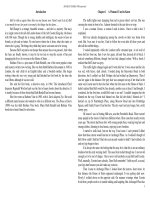spanish around the house
Bạn đang xem bản rút gọn của tài liệu. Xem và tải ngay bản đầy đủ của tài liệu tại đây (1.36 MB, 300 trang )
Spanish
Around the
House
This page intentionally left blank.
José M. Díaz and María F. Nadel
The Quick Guide to Communicating
with Your Spanish-Speaking Employees
Spanish
Around the
House
Copyright © 2005 by The McGraw-Hill Companies, Inc. All rights reserved. Manufactured in
the United States of America. Except as permitted under the United States Copyright Act of
1976, no part of this publication may be reproduced or distributed in any form or by any
means, or stored in a database or retrieval system, without the prior written permission of the
publisher.
0-07-146947-8
The material in this eBook also appears in the print version of this title: 0-07-144437-8.
All trademarks are trademarks of their respective owners. Rather than put a trademark symbol
after every occurrence of a trademarked name, we use names in an editorial fashion only, and
to the benefit of the trademark owner, with no intention of infringement of the trademark.
Where such designations appear in this book, they have been printed with initial caps.
McGraw-Hill eBooks are available at special quantity discounts to use as premiums and sales
promotions, or for use in corporate training programs. For more information, please contact
George Hoare, Special Sales, at or (212) 904-4069.
TERMS OF USE
This is a copyrighted work and The McGraw-Hill Companies, Inc. (“McGraw-Hill”) and its
licensors reserve all rights in and to the work. Use of this work is subject to these terms.
Except as permitted under the Copyright Act of 1976 and the right to store and retrieve one
copy of the work, you may not decompile, disassemble, reverse engineer, reproduce, modify,
create derivative works based upon, transmit, distribute, disseminate, sell, publish or
sublicense the work or any part of it without McGraw-Hill’s prior consent. You may use the
work for your own noncommercial and personal use; any other use of the work is strictly
prohibited. Your right to use the work may be terminated if you fail to comply with these
terms.
THE WORK IS PROVIDED “AS IS.” McGRAW-HILL AND ITS LICENSORS MAKE NO
GUARANTEES OR WARRANTIES AS TO THE ACCURACY, ADEQUACY OR
COMPLETENESS OF OR RESULTS TO BE OBTAINED FROM USING THE WORK,
INCLUDING ANY INFORMATION THAT CAN BE ACCESSED THROUGH THE WORK
VIA HYPERLINK OR OTHERWISE, AND EXPRESSLY DISCLAIM ANY WARRANTY,
EXPRESS OR IMPLIED, INCLUDING BUT NOT LIMITED TO IMPLIED WARRANTIES
OF MERCHANTABILITY OR FITNESS FOR A PARTICULAR PURPOSE. McGraw-Hill
and its licensors do not warrant or guarantee that the functions contained in the work will meet
your requirements or that its operation will be uninterrupted or error free. Neither McGraw-
Hill nor its licensors shall be liable to you or anyone else for any inaccuracy, error or omission,
regardless of cause, in the work or for any damages resulting therefrom. McGraw-Hill has no
responsibility for the content of any information accessed through the work. Under no
circumstances shall McGraw-Hill and/or its licensors be liable for any indirect, incidental,
special, punitive, consequential or similar damages that result from the use of or inability to
use the work, even if any of them has been advised of the possibility of such damages. This
limitation of liability shall apply to any claim or cause whatsoever whether such claim or cause
arises in contract, tort or otherwise.
DOI: 10.1036/0071469478
Want to learn more?
We hope you enjoy this
McGraw-Hill eBook! If
you’d like more information about this book,
its author, or related books and websites,
please
click here.
Contents
Introduction xv
How to Use This Book xv
1 Job Application and Interview
Solicitud de empleo y entrevista 1
Interviewing Prospective Employees
Para entrevistar a un futuro empleado 1
Interview Questions
Preguntas para la entrevista 2
Greetings and Polite Exchanges
Saludos e intercambios de cortesía 15
2 The Family
La familia 21
Relatives
Los parientes 21
Describing a Person Physically
Para describir a una persona físicamente 23
Describing a Person’s Personality and Intelligence
Para describir la personalidad y la inteligencia de una persona 24
Describing a Person’s Emotions and Feelings
Para describir las emociones y los sentimientos de una persona 25
v
For more information about this title, click here
Describing a Person’s Religion
Para describir la religión de una persona 26
Describing a Person’s Nationality
Para describir la nacionalidad de una persona 26
3 The House
La casa 29
Parts of the House
Las partes de la casa 29
Electrical Devices
Los aparatos eléctricos 31
In the Living Room
En la sala 31
In the Bedroom
En el dormitorio/el cuarto de dormir 32
In the Bathroom
En el baño 33
In the Home Office
En la oficina en casa 34
Chores and Cleaning the House
Los quehaceres y la limpieza de la casa 37
In the Laundry Room/Laundromat
En la lavandería 39
At the Dry Cleaners
En la tintorería 42
Mending Clothes
Para remendar la ropa 42
In an Apartment Building
En un edificio de apartamentos 43
vi Contents
4 In the Kitchen
En la cocina 45
Electrical Appliances in the Kitchen
Los aparatos eléctricos en la cocina 45
Containers and Utensils
Los envases y los utensilios 46
Meals
Las comidas 47
Breakfast
El desayuno 48
Meats
Las carnes 49
Poultry
Las aves de corral 50
Shellfish
Los mariscos 50
Fish
Los pescados 50
Fruits
Las frutas 51
Vegetables
Los vegetales 52
Grains
Los granos 53
Spices and Ingredients
Las especias y los ingredientes 53
Drinks
Las bebidas 54
Recipes
Las recetas 56
In the Dining Room
En el comedor 59
Contents vii
To Express Your Opinion About Food
Para expresar su opinión sobre la comida 60
5 In the Garden and on the Patio
En el jardín y en el patio 63
Flowers and Plants
Las flores y las plantas 63
Tre es
Los árboles 64
Taking Care of the Garden
El cuidado del jardín 65
Taking Care of the Pool
El cuidado de la piscina 68
Pets
Los animales domésticos 69
Parts of an Animal’s Body
Las partes del cuerpo de un animal 69
Caring for Pets
El cuidado de los animales domésticos 70
Farm Animals
Los animales en la finca 72
6 Fixing the House
Para reparar la casa 73
Trades
Los oficios 73
Explaining Problems
Para explicar los problemas 74
Finalizing the Contract
Para finalizar el contrato 76
The Electrician
El/la electricista 77
viii Contents
The Plumber
El plomero/la plomera 78
The Painter
El pintor/la pintora 78
The Carpenter
El carpintero/la carpintera 79
Construction Materials
Los materiales de construcción 81
Measurements, Size, and Weight
Las medidas, el tamaño, y el peso 82
7 Places Around Town
Los lugares en el pueblo 83
Around the Neighborhood
Por el barrio 83
Traf fic Signs
Las señales de tráfico 86
Getting Around Town
Para ir de un lugar a otro 86
At the Bank
En el banco 88
At the Post Office
En la oficina de correos 89
In the Barbershop/Beauty Salon
En la barbería/la peluquería 90
8 At the Service/Gas Station
En el taller de reparaciones/la gasolinera 93
Types of Vehicles
Tipos de vehículos 93
The Car (Inside and Out)
El coche/el carro (por dentro y por fuera) 94
Contents ix
At the Gas Station
En la gasolinera 96
Things to Do at the Service/Gas Station
Lo que se hace en el taller de reparaciones/la gasolinera 96
Check-Ups and Repairs of the Car
El mantenimiento y arreglo del coche 98
9 Shopping
De compras 101
Transac tions
Las transacciones 101
Shopping Vocabulary
Vocabulario para hacer las compras 103
At the Grocery Store
En la tienda de comestibles 105
At the Pharmacy/Drugstore
En la farmacia 107
10 Clothing
La ropa 111
Articles of Clothing
Las prendas de vestir 111
Clothing Accessories
Los complementos para la ropa 113
Parts of Garments
Las partes de las prendas de vestir 114
Shopping for Clothes
Para comprar ropa 115
Jewelry
Las joyas 118
x Contents
11 Family Health and Well-Being
La salud y el bienestar de la familia 121
At the Doctor’s Office
En el consultorio del médico 121
Parts of the Body
Las partes del cuerpo 123
Symptoms
Los síntomas 124
Illnesses
Las enfermedades 125
Recommendations
Las recomendaciones 126
Giving Medication to Children
Para darles medicina a los niños 127
Accidents
Los accidentes 128
Medical Equipment and Devices
Los aparatos médicos 129
In an Emergency
En una emergencia 130
At the Dentist’s Office
En el consultorio del dentista 131
Eye Care
El cuidado de los ojos 132
12 Taking Care of the Children
El cuidado de los niños 13 3
In the Children’s Bedroom
En el dormitorio de los niños 133
Toys and Playthings
Los juguetes y otras cosas para jugar 134
Children’s Likes and Dislikes
Lo que les gusta o no les gusta a los niños 135
Contents xi
Rules of Behavior for Children
Las reglas de comportamiento para los niños 136
Daily Routine
La rutina diaria 136
Other Obligations
Otras obligaciones 137
Dangers Around the House
Los peligros en la casa 140
Talking About School
Para hablar sobre la escuela 141
13 Social and Cultural Activities
Las actividades sociales y culturales 14 5
Family Celebrations/Parties
Las celebraciones familiares/las fiestas 145
National and Religious Holidays
Las fiestas nacionales y religiosas 146
Renting Videos
Para alquilar vídeos 147
At the Museum
En el museo 148
Sports and Exercise
Los deportes y el ejercicio 149
Talking About the Weather
Para hablar del tiempo 152
14 Numbers
Los números 15 5
Cardinal Numbers
Los números cardinales 155
Fractions
Las fracciones 157
Ordinal Numbers
Los números ordinales 158
xii Contents
Days and Dates
Los días y las fechas 159
Time
La hora 160
Appendix A: The Sounds of Spanish 165
Pronouncing Spanish Vowels 165
Pronouncing Spanish Diphthongs 166
Pronouncing Spanish Consonants 168
General Guidelines for Speaking Spanish 172
Linking Groups of Spanish Words 173
Division of Words into Syllables 174
Appendix B: Grammar Essentials 177
Nouns and Articles 177
Adjectives 178
Possessive Adjectives 179
Demonstrative Adjectives 180
Adverbs 181
Subject Pronouns 181
Verbs 182
Asking Questions 200
Negative Sentences 201
Appendix C: Dictionary 203
English-Spanish 203
Spanish-English 238
Index 273
Contents xiii
This page intentionally left blank.
Introduction
Spanish Around the House is a comprehensive, easy-to-follow book that
offers the essential tools for communicating with Spanish-speaking per-
sonnel and/or employees. The authors have selected some occupations in
which you will most likely encounter Spanish speakers and have created a
book that will help you communicate with these workers and deal with
different aspects of their employment. Any attempt you make to commu-
nicate in Spanish will help you to establish a good working relationship
with these workers by demonstrating respect and appreciation of their cul-
ture. At the same time, it will be a satisfactory experience for you to use
this book as a point of departure to increase your knowledge of the Span-
ish language. As your ability to understand the workers improves, you can
also use your knowledge to help them improve their knowledge of English.
The Spanish used in this book is standard Spanish that can be under-
stood by any native speaker of the language. It would be impossible to
cover all the regionalisms found in the Spanish-speaking countries, but
once you become familiar with the vocabulary that appears in this book,
you will be able to add to the basics and learn new expressions from the
Spanish speakers you encounter. The phonetic pronunciation for the Span-
ish terms are included.
The book is divided into fourteen chapters. Each chapter includes lists
of useful vocabulary that are grouped thematically when possible.
How to Use This Book
You can use this book with very little (or no) preparation. There is noth-
ing in particular you need to know in order to use any given chapter. You
xv
Copyright © 2005 by The McGraw-Hill Companies, Inc. Click here for terms of use.
can choose a topic that interests you, or you can begin with Chapter 1 and
go on from there. And, of course, you can do one or the other depending
on your needs at any given time.
As we were trying to come up with some guidelines for using this book,
we realized that how you use it depends on the reason you are using it and
what is going on at any given moment in the life of your family or busi-
ness. This will greatly affect where you begin and what chapters you con-
centrate on. If, for example, you have household help, you might start with
Chapters 3 and 4. If your children have a Spanish-speaking caretaker, you
might begin with Chapter 12. Are there Spanish-speaking employees at
your place of business or in the places where you participate in social activ-
ities? In that case, you might turn your attention to Chapters 1 and 13.
Vocabulary
Building a large store of words is important for spoken language. This
book is full of everyday words, phrases, and expressions and provides an
opportunity to learn words and sentences without worrying about gram-
mar. Each chapter includes lists of useful vocabulary related to the theme
of the chapter. We have attempted to use the most generic word, but it
would be virtually impossible to cover all the regionalisms found in
Spanish-speaking countries. Generally, we have chosen a word that is com-
monly used in America. As you read through a section, it is not neces-
sary to learn all the words presented, but obviously the more vocabulary
you commit to memory, the more confident and fluent your Spanish will
be. Some things that will help you are:
1. You may want to create your own personalized vocabulary by writ-
ing down the words you find most useful and practicing them out loud reg-
ularly. If you decide to create personalized lists, it is a good idea to keep
separate lists for nouns, adjectives, and verbs. These lists could be further
separated into:
Nouns: feminine/masculine
Verbs: ending in -ar, -er, or -ir
Doing this will not only help you to remember the words, it will help
you to use them.
xvi Introduction
2. You should make it a point to practice and expand what you are
learning with the Spanish speakers you encounter. They will also be a valu-
able source of regionalisms from their country of origin.
3. The English-Spanish/Spanish-English dictionary in Appendix C of
this book focuses on the Spanish used at home or in home-related activi-
ties. Use it for quick reference to answer the questions: “How do you say
that in Spanish?” or “How do you say that in English?” (¿Cómo se dice en
español? [koh-moh seh dee-seh ehn ehs-pah-nyohl] ¿Cómo se dice en
inglés? [koh-moh seh dee-seh ehn een-glehs]). Note that the thematic
vocabulary lists in individual chapters of this book are more detailed and
specific than the dictionary vocabulary presented in Appendix C.
Grammar
This is not a grammar book, but throughout the book comments about
Spanish grammar and notes refer you to the grammar presentations in
Appendix B, “Grammar Essentials.” Studying these sections will allow you
to deepen your knowledge of a given grammar point.
It is not necessary to become confident with all the topics discussed in
Appendix B before turning back to the main text. It is up to you to decide
how thoroughly you want to cover a given topic.
If, however, you are interested in learning more about Spanish gram-
mar, you can use Appendix B for a more thorough study. Going through
this appendix in detail will allow you to learn the basics without turning
to another textbook.
When using the grammar section, make sure to read the examples care-
fully. Not only do they illustrate the grammar point, they also show you
the differences between English and Spanish, which very often do not allow
word-for-word translation of sentences.
Pronunciation
In addition to knowing the sounds of the letters in Spanish, you need
some knowledge of stress and intonation in order to acquire authentic
pronunciation. These aspects are covered in Appendix A, “The Sounds of
Spanish.” This appendix is geared to beginners and will help you move
toward authentic pronunciation.
Introduction xvii
To further ease communication, we have included the phonetic pro-
nunciation of every Spanish word and phrase used in the book. The
stressed syllable appears in bold-face type.
Don’t forget that your best source for pronunciation is the Spanish
speaker with whom you are communicating. Don’t hesitate to ask him or
her to pronounce any word or phrase you need. Spanish speakers are always
willing to help those who try to communicate with them in Spanish. Lis-
ten and imitate the sounds they make.
It also helps to listen to Spanish being spoken every chance you get.
Spanish-speaking television newscasters are excellent models, and since
you may already be familiar with the topic, you may understand some of
the language. You may want to record sections of a program (sports,
weather, soap operas, etc.), and listen to them repeatedly.
You can also record your speech and then listen to yourself as a way to
check your pronunciation.
Practice
In conclusion, the only way to learn a language is to use it. Take every
opportunity you are given to practice, practice, and practice some more.
If you wait until you can say something perfectly, you will never speak
Spanish. Take chances! You will not only learn to communicate in Span-
ish, you will also establish new relationships, cement old ones, and learn
more about the world around us, here in the United States and Canada and
to the south.
xviii Introduction
Spanish
A
round the
H
ouse
This page intentionally left blank.
Interviewing Prospective Employees
Para entrevistar a un futuro empleado
(pah-rah ehn-treh-bees-tahr ah oon foo-too-roh ehm-pleh-ah-doh)
The best way to get to know a prospective employee may be through a job
application. The application form that begins on page 3 can be used as a
point of departure to establish a conversation and to find out if the appli-
cant truly meets your expectations for an employee. It also makes a good
record of information that you may need to access in the future. The
information requested on the form appears in both Spanish and English.
Although while designing this form the authors tried to be as comprehen-
sive as possible, there are always special situations that may require further
questions. The design and organization of this book will help you to find
easily those words and expressions you may need to get to know your pro-
spective employee further.
Please note that some of the questions that follow ask information
about the applicant that may be sensitive. It is up to you to find the right
moment to ask them. Although it may be sensitive in nature, this infor-
mation may still be important for you to know.
1
1
Job Application and Interview
Solicitud de empleo y entrevista
(soh-lee-see-tood deh ehm-pleh-oh ee ehn-treh-bees-tah)
Copyright © 2005 by The McGraw-Hill Companies, Inc. Click here for terms of use.
Keep in mind that the laws of the United States do not allow you to ask
certain specific questions such as marital status, age, etc., of the applicant.
You’ll need to become familiar with those laws. Useful sources are avail-
able at your local public library.
On the application form that begins on page 3, the word apellidos (last
names) appears in the plural. That is because in Spanish-speaking coun-
tries most people use two last names: their father’s last name first and then
their mother’s maiden name. Married women usually retain their maiden
name and then add de followed by their husband’s last name (i.e., de Gar-
cía, etc.). This is, of course, changing with the times. But you may still meet
many women who follow the traditional custom.
Interview Questions
Preguntas para la entrevista
(preh-goon-tahs pah-rah lah ehn-treh-bees-tah)
The questions below appear in the same order as the information
requested on the application form; that way you can ask them out loud as
you go through the application. Some of the questions may repeat those
on the form, but you can use them as a point of departure to start a
conversation going or if you are not able to, or decide not to, use an
application form. Don’t forget to take notes.
Personal Information
Información personal
(een-fohr-mah-syohn pehr-soh-nahl)
What is your name?
¿Cómo se llama usted?
1
(koh-moh seh yah-mah oos-tehd)
What are your last names?
¿Cuáles son sus apellidos?
(kwah-lehs sohn soos ah-peh-yee-dohs)
2 Spanish Around the House
1. Notice that in Spanish the upside-down question mark introduces a question. A regular
question mark ends the question.
Job Application and Interview 3
EMPLOYMENT APPLICATION
SOLICITUD DE EMPLEO
Personal Information
Información personal
Name: Last names:
Nombre: Apellidos:
Address:
Dirección:
Telephone:
Teléfono:
Country of birth:
País de nacimiento:
Social Security number:
Número de seguro social:
Car: Yes No
Coche: Sí No
Have you studied in a high school? Yes No
¿Ha estudiado en una escuela secundaria? Sí No
If you have studied, up to what grade did you finish?
Si ha estudiado, ¿qué grado terminó?
Work Experience
Experiencia de empleo
1. Dates:
Fechas:
( )
( )









